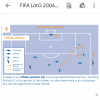Law 11 says nothing about "putting pressure" on a defender. Nothing.
The early flag where only the OSP attacker is pursuing and is likely to get the ball is an example of interfering with PLAY being flagged early as it is the only thing that is going to happen.
If an OSP attacker and an onside attacker are pursuing, to flag for interfering with PLAY, the AR/R must wait to see who gets there first.
@one posted the only ways (other than the inapplicable here blocking vision or impeding the path of a defender) in which an OSP player can interfere with AN OPPONENT. Running toward the ball is not considered an "obvious action" in this context. Law 11 is looking for something more concrete, such as a dummy. The expectation on all three is that the activity happens near the ball.



 .
.
